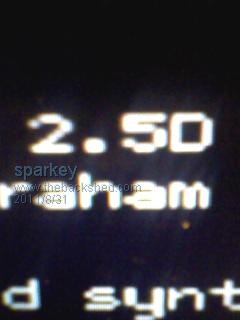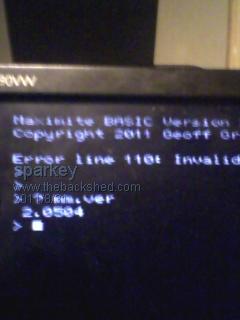
|

|
Forum Index : Microcontroller and PC projects : Maximite Test ver 2.5C - with serial, I/O
| Author | Message | ||||
| sparkey Senior Member Joined: 15/06/2011 Location: AustraliaPosts: 819 |
thanks geoff i will awaight your response i`m not in great demand but others may be having the same prob so thats cool for now 2 point 5 b works and does the trick for them as well regards sparkey :also the led started flashing once the firm had finished the up date thoug was not on whilst the programming was going on sorry i did not note this earlier regards .... technicians do it with least resistance |
||||
| Geoffg Guru Joined: 06/06/2011 Location: AustraliaPosts: 3194 |
OK, I fixed the two bugs. A new version (2.5D) is available from: http://geoffg.net/Downloads/Maximite/Maximite_Update_V2.5D.z ip Thanks very much sparkey and Bob. The hardest part of fixing a bug is finding it in the first place! Much appreciated. Wiz, I reworked the USB timing and it might have fixed your issue also. Geoff Geoff Graham - http://geoffg.net |
||||
| sparkey Senior Member Joined: 15/06/2011 Location: AustraliaPosts: 819 |
thank`s geoff well its running on my altronics thanks for the bug fix so i spose thats ok fo me and bob who replied ....i usully try your hex code when you post it regards sparkey .... :: mm.ver "2.0504" technicians do it with least resistance |
||||
jman Guru Joined: 12/06/2011 Location: New ZealandPosts: 711 |
Thanks Geoff I confirmed the bug with the USB disconnected (After appling 2.5c I never gave it a thought to remove the USB) Fix has resolved the issue Many Thanks John |
||||
| sparkey Senior Member Joined: 15/06/2011 Location: AustraliaPosts: 819 |


this is after geoff modded the "hex' on an origanal altronics maxi-m... :: regards sparkey...... technicians do it with least resistance |
||||
| wizard Newbie Joined: 29/07/2011 Location: United StatesPosts: 38 |
Hi Geoff :), 2.5D runs here !! :). Thank you. USB is still no-go. Of interest my chips have ID 04307053. They may be early evaluation versions or some such. At least two of these chips will not start running at 80Mhz without the help of a heat-gun! So you plug in the USB (for power) and heat the chip until my debugger starts. Then 0x9d004000 go. Perhaps the low-esr caps were a fix along the way to getting the PIC32 chips to really work as specified? The PIC32 on my ChipKit MAX32, which is not in active use right now, seems to be of a much more recent vintage? In case it of interest. I "edit" your .hex file and strip out a few bits to make a linear 1d00xxxx hex load and then use srec_cat to convert it to binary. Then into my parallel port j-tag loader. All code is either open source or code I have written/modified. The compiler chain is based on VillageTelco version of openwrt.org. and is also all open source :). And works fine with the PIC32 code I have written or recompiled from various open sources. No IDE! Just a simple makefile! With a few headers and some code substitutions, I expect MMBasic could become fully open source? I wonder which ethernet chips you are looking at? From here w5100 looks like the easiest but not the cheapest. Recently I uninstalled and then reinstalled the Microchip IDE to get it to compile 2.5. The newly recompiled 2.5 seems to run OK! warm regards, Wiz |
||||
| Geoffg Guru Joined: 06/06/2011 Location: AustraliaPosts: 3194 |
Wow, a heat gun! That is a flaky chip. Pity about the USB but from what you say I could believe that the chip has a problem. Someday I plan to make a universal version of MMBasic not tied to a particular chip. It would only take about a week but even finding that time is difficult. I have not looked at the Ethernet chip set yet. It is a great pity that Microchip could not integrate the physical layer as they did with USB. That would have been perfect. Geoff Geoff Graham - http://geoffg.net |
||||
VK6MRG Guru Joined: 08/06/2011 Location: AustraliaPosts: 347 |
Not sure if this is an issue this the updated hex file or not, but, I've tried to use HyperTerminal with the 2.5C and have not been able to "log on" to the Maximite. I have reloaded Ver 2.5 and no problems. Any clues?  Its easier to ask forgiveness than to seek permission! ............VK6MRG.............VK3MGR............ |
||||
VK6MRG Guru Joined: 08/06/2011 Location: AustraliaPosts: 347 |
And same problem with the Ver 2.5D update. Its easier to ask forgiveness than to seek permission! ............VK6MRG.............VK3MGR............ |
||||
VK6MRG Guru Joined: 08/06/2011 Location: AustraliaPosts: 347 |
And on the topic of updating the firmware, how many times can we write to the pic chip before it wears out so to speak?  Its easier to ask forgiveness than to seek permission! ............VK6MRG.............VK3MGR............ |
||||
| BobDevries Senior Member Joined: 08/06/2011 Location: AustraliaPosts: 266 |
I'm using V2.5D using the Silicon Chip USB Serial Port (as COM3). No problem here. Regards, Bob Devries Dalby, QLD, Australia |
||||
| sparkey Senior Member Joined: 15/06/2011 Location: AustraliaPosts: 819 |
if you read the note`s that are explained in the maxi-m "loading firm whare".. it seem`s that it is endless ...given the fact that it is a eerom..or eeprom either way it holds the code... if the hardware holds up to the test of time then it should be indefinite... technicians do it with least resistance |
||||
| aargee Senior Member Joined: 21/08/2008 Location: AustraliaPosts: 255 |
A lot. (As in "How much do you hate the Romans?") Probably find it will be something like... "...loading the maximite firmware once an hour until the sun expands to consume the earth..." 
- Rob For crying out loud, all I wanted to do was flash this blasted LED. |
||||
Xiongmao Regular Member Joined: 25/08/2011 Location: AustraliaPosts: 48 |
IIRC, the sheet for one the PICs mentions a MTBF of 100,000 writes for the flash and 1,000,000 for the eeprom. I would presume the PIC32 would be similar. |
||||
| jebz Regular Member Joined: 13/06/2011 Location: AustraliaPosts: 79 |
An easy add on would be a ENC28J60 Ethernet Chip with the serial interface. It's no bigger than the physical layer chip required to work with the PIC32. A built version like this from Futurlec could be used - http://www.futurlec.com.au/Mini_Ethernet.jsp |
||||
| seco61 Senior Member Joined: 15/06/2011 Location: AustraliaPosts: 205 |
The datasheet specifies a minimum of 1000 erase/write cycles. So I doubt that the average (or even above average??) person should be worried. I have probably reprogrammed mine a 100 or more times as I develop and test firmware - and I suspect that I do it a lot more often than most! Regards Gerard (vk3cg/vk3grs) |
||||
| vasi Guru Joined: 23/03/2007 Location: RomaniaPosts: 1697 |
From the data sheet of PIC18F4550, 5Vcc tech: [quote]• 100,000 Erase/Write Cycle Enhanced Flash Program Memory Typical • 1,000,000 Erase/Write Cycle Data EEPROM Memory Typical[/quote] Later on, on data sheet of PIC18F46J50, in 3.3Vcc tech: [quote]• Flash Program Memory of 10,000 Erase/Write Cycles Minimum and 20-Year Data Retention[/quote] I don't know how it is for PIC32, here is a quote form Chipkit forums: [quote=GeneApperson]The PIC32 parts don't have internal EEPROM. In both the Uno32 and the Max32, the last 4K of the program flash is reserved for use to simulate EEPROM. However, due to wearout limits of the flash (it's only rated for 1000 erase cycles) the flash can't be direct mapped to eeprom. The library treats the 4K as content addressable memory and stores both the eeprom address and the value in a 32 bit word. The result is 1Kbyte of simulated EEPROM and a page erase doesn't have to occur until 1K writes have occured.[/quote] What means that? It is important, as we work with development boards and are not so cheap... Vasi Edit:_______________________ [quote=GeneAPperson][quote=TECH GEEK]ok, but what is the aprox. amount of time I can erase then load a 500k program?[/quote]I don't really know. The PIC32MX5XX/6XX/7XX Family Data Sheet lists the program flash cell endurance as a minimum of 1000 erase/write cycles. They don't give a typical figure. Generally, these figures are conservative and the actually endurance is probably quite a bit greater, and will vary from chip to chip. Gene Apperson Digilent[/quote] Hobbit name: Togo Toadfoot of Frogmorton Elvish name: Mablung Miriel Beyound Arduino Lang |
||||
VK6MRG Guru Joined: 08/06/2011 Location: AustraliaPosts: 347 |
The WIB uses the same 28J60 in DIP format. And as the WIB is a PIC based project, implementing it into the Maximite shouldn't be to difficult.  Its easier to ask forgiveness than to seek permission! ............VK6MRG.............VK3MGR............ |
||||
| vasi Guru Joined: 23/03/2007 Location: RomaniaPosts: 1697 |
With other words, design your application in PIC24F, do a lot of tests and corrections then prepare it for PIC32 (which Microchip says that is pin compatible with). Vasi Suddenly, I see interpreters for PIC32 having a great value if they don't write in Flash as is doing stickos (I may be wrong). And particularly, writing on USB HDD may be even great!!! Hobbit name: Togo Toadfoot of Frogmorton Elvish name: Mablung Miriel Beyound Arduino Lang |
||||
| wizard Newbie Joined: 29/07/2011 Location: United StatesPosts: 38 |
Hi All, Heat gun boot is a drag  . .
I suspect that once PCBs are out and new chips are in, this problem may be a thing of the past? I would be careful of the J60 ethernet chip. It has a fatal bug in my opinion. If the ethernet is not wired correctly (very common) the chip doesn't not receive data reliably. So far Microchip still has this problem on their chip errata page. Most other chips just keep running if the wires are reversed, etc. I assume the W5100 used by the arduino folks does not have this problem? Does anyone know for sure? warm regards, Wiz |
||||